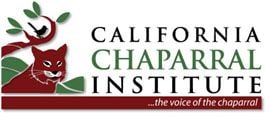Chaparral Preservation Plan
They are filled with chaparral, not forests.
Due to the significant changes that have occurred in Southern California over the past century, it is crucial that steps be taken now to insure that current and future generations will be able to enjoy the treasures set aside for them over a century ago:the Cleveland, San Bernardino, Angeles, and Los Padres National Forests.
The best way to do so is to change the classification and management of these public land trusts in a way that is consistent
The best way to do so is to change the classification and management of these public land trusts in a way that is consistent
with the needs of a rapidly growing population. All four national forests are mostly native shrublands, not forests.
Future generations will be forever grateful if we act now to manage the four southern California National Forests in a manner which will preserve and enhancetheir scenic, natural, and historical qualities.
The California Chaparral Preservation Plan offers a way to do so.
What's in a Name? A lot
The majority of the four southern California National Forests are not forests at all, they are mostly native shrublands. Therefore, it's no wonder most people are not familiar with these four national preserves -their names do not reflect what they actually have within.
Executive Summary
In a remarkable display of foresight and political courage, President Theodore Roosevelt withdrew millions of acres of federal land from unregulated commercial development and protected them for future citizens. Roosevelt's Forest Reserve system demonstrated a rejection of the old model of resource exploitation and created instead the world's largest public land protectorate to be held in trust for every single American.Referring to this land trust, Jack Ward Thomas, Chief Emeritus of the US Forest Service, wrote, "These forests were all different but, in one critical sense, they were all the same. They belonged to me, to my children, and to all the American people for today, tomorrow, and forever... unless somehow, we allow this incredible birthright to be stolen or frittered away."
There is a distinct possibility that this birthright may indeed be frittered away in the four National Forests of Southern California (the Cleveland, San Bernardino, Angeles, and Los Padres) because of inappropriate management objectives. These four federal land trusts are different from all the others in the National Forest System because they are almost exclusively used for recreation by a growing population. In addition, these lands are not typically covered by forests at all but by unique shrubland ecosystems, especially chaparral.
Since the passing of the Multiple-Use Sustained Yield Act of 1960, the guiding principle behind national forest policy has been "to achieve quality land management under the sustainable multiple-use management concept to meet the diverse needs of people." This includes grazing, timber production, hydroelectric dams, landfills, utility corridors, and other invasive activities. While the multiple-use doctrine may be a workable management strategy in some national forests far from major cities, it is becoming an increasingly unsuccessful and contentious model for the four National Forests in Southern California, all heavily impacted by a rapidly growing population.
These four forests need to be viewed and managed for what they are: urban parks that provide citizens opportunities to renew their enthusiasm for life as well as land preserves that protect the valuable wildlands found within. By continuing the current forest management model of multiple-use there is a significant danger these lands will be lost by multiple-degradation as they are exploited for a wide range of consumptive uses.
Many US Forest Service personnel within the four National Forests of Southern California have strived to protect the chaparral ecosystem from improper management priorities, but they are often frustrated by the commodity-based, "forest-focus" perspective driven by regional and national offices. New policies changing the management focus of these four National Forests are needed to protect California's valuable chaparral ecosystems and ensure that our families and future generations will always have a place to enjoy nature. We offer four proposals for such legislative action:
1. Create Waheto National Park and the Grizzly Bear National Monument from lands within and adjacent to the Cleveland National Forest. Please see our Waheto National Park and Grizzly Bear National Monument pages for more information.
2. Designate the Cleveland, Angeles, San Bernardino, and Los Padres National Forests as National Chaparral Recreation Areas (NCRAs).
3. Develop sustainable, ecologically-based resource and fire management plans in order to protect surrounding communities, preserve old-growth stands of chaparral, and prevent further type-conversion of native plant communities within the four NCRAs.
4. Create Natural History Education/Recreation Districts adjoining the new National Chaparral Recreation Areas.
